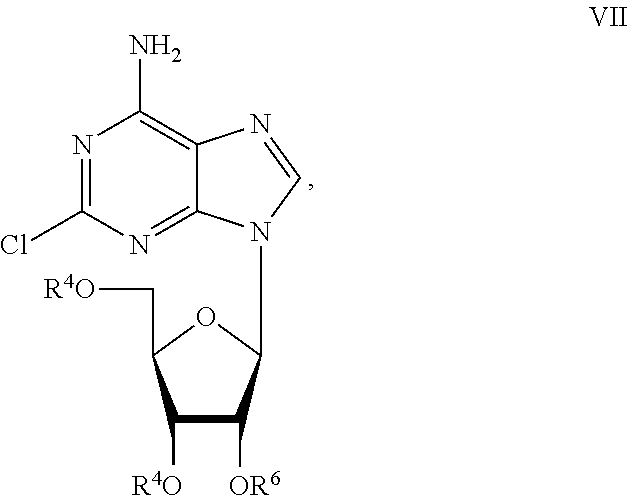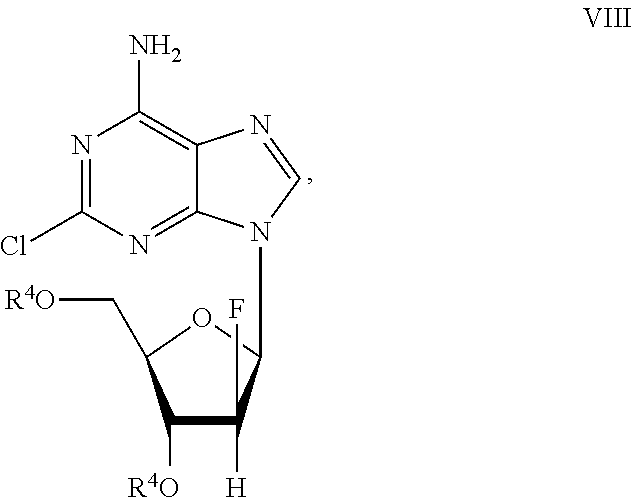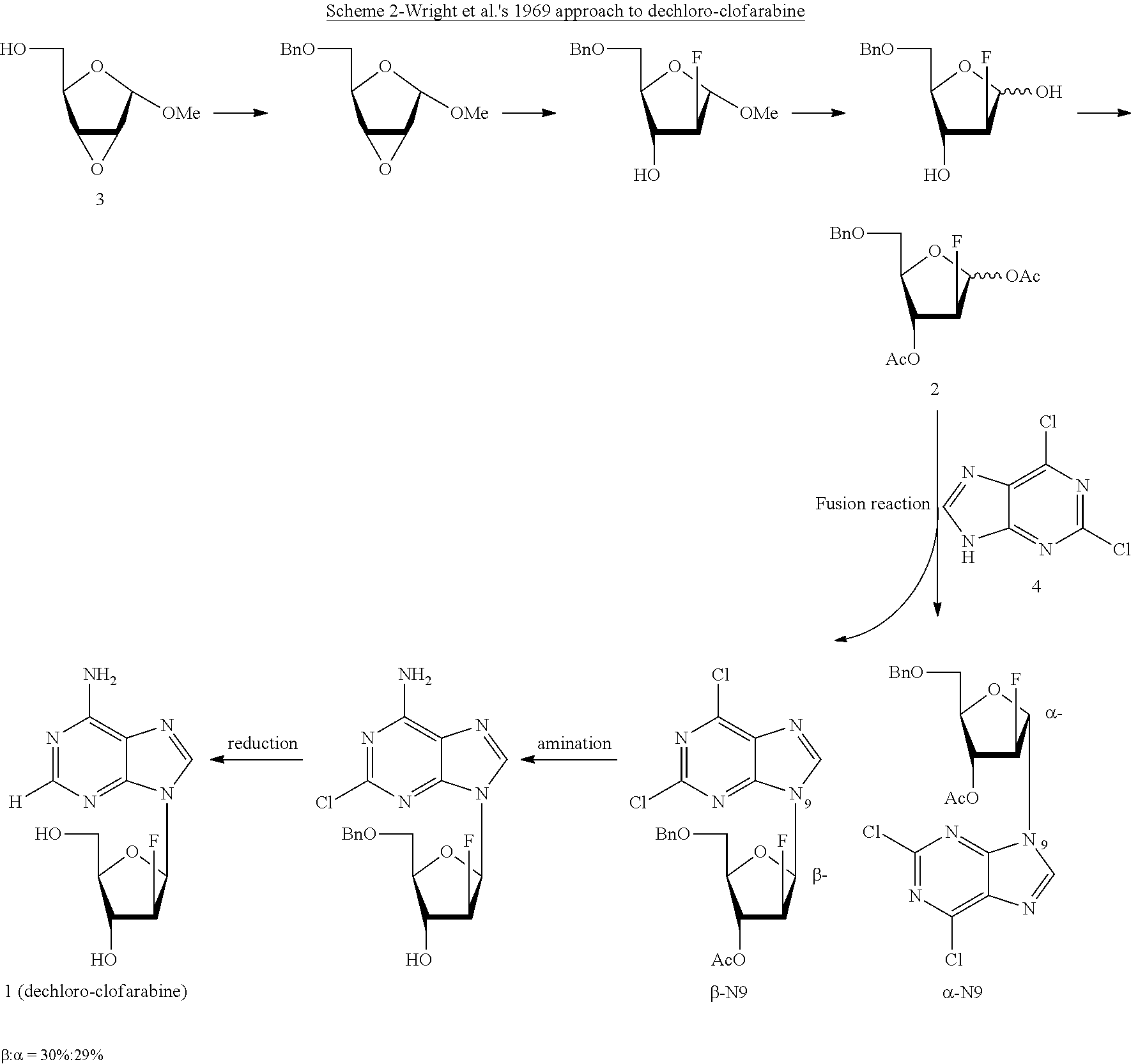Preparation of 2-chloro-9-(2'-deoxy-2'-fluoro-Beta-D-arabinofuranosyl)-adenine
a technology of arabinofuranosyl and adenine, which is applied in the field of preparation of 2chloro9(2'deoxy2'fluorobetadarabinofuranosyl)adenine, can solve the problems of inability to scale up, inability to provide the desired -anomer of 6 yield, and inherently inefficient coupling step
- Summary
- Abstract
- Description
- Claims
- Application Information
AI Technical Summary
Benefits of technology
Problems solved by technology
Method used
Image
Examples
example 1
Preparation of 2′,3′,5′-tri-O-benzoyl-2-chloroadenosine (D)
[0091]Under an atmosphere of N2(g), 2-chloroadenine (A (9), 50 g, 294.9 mmol), MeCN (600 mL), and BSTFA (227.5 g, 883.8 mmol) were stirred and heated under reflux until the mixture turned mostly clear (about 1 h). TfOH (8.77 g, 58.5 mmol) and 1-O-acetyl-2,3,5-tri-O-benzoyl-β-D-ribofuranose (C, 142.5 g, 282.5 mmol) were sequentially added into the mixture and were stirred at reflux for about 1 h. The mixture was cooled to 20-35° C. and diluted with MTBE (500 mL), and washed over a 0.5 to 1 h period with saturated NaHCO3 (750 mL). The organic phase was evaporated in vacuo at 40 to 50° C. to give 2′,3′,5′-tri-O-benzoyl-2-chloroadenosine (D): 1H NMR (300 MHz, CDCl3) δ 7.9-8.1 (m, 6H), 7.94 (s, 1H), 7.3-7.6 (m, 9H), 6.45 (d, J=2.7 Hz 1H), 6.15 (m, 2H), 5.30 (s, 2H), 4.90 (dd, J4′,5a=3.2 Hz, J5′a,5′b=12.0 Hz, 1H), 4.82 (m, 1H), 4.72 (dd, J4′,5a=4.1 Hz, J5′a,5′b=12.0 Hz, 1H); 13C NMR (75 MHz, CDCl3) δ 166.3, 165.5, 165.4, 156.4, 15...
example 2
Preparation of 2-chloro-9-(3′,5′-di-O-benzoyl-β-D-ribofuranosyl)-adenine (F)
[0092]To 2′,3′,5′-tri-O-benzoyl-2-chloroadenosine (D) prepared above was charged AcOH (277 g), pyridine (1109.6 g) and 80% hydrazine hydrate (73.8 g, 1.18 mol) at room temperature The mixture was heated to 75 to 80° C. under an atmosphere of N2(g) until the HPLC purity of compound F stopped increasing within a 2 h period (usually required between 6 to 10 h). The mixture was cooled to 35° C. and diluted with MIBK (3774.4 g) and was then washed at 2SO4 (3378 mL) to remove hydrazine and pyridine. The organic phase was washed with saturated NaHCO3 (1734 mL) Until the amount of AcOH in the organic solution phase was not more than 0.5 weight %, as determined by GC assay. The organic phase was evaporated in vacuo at 65° C. until no more distillate was collected to give an approximately 2:1 mixture of 2-chloro-9-(3′,5′-di-O-benzoyl-$-D-ribofuranosyl)-adenine (F) and 2-chloro-9-(2′,5′-di-O-benzoyl-β-D-ribofuranosyl)-...
example 3a
Enrichment of 2-chloro-9-(3′,5′-di-O-benzoyl-β-D-ribofuranosyl)-adenine (F) from a mixture of 2-chloro-9-(2′,5′-di-O-benzoyl-β-D-ribofuranosyl)-adenine (E) and 2-chloro-9-(3′,5′-di-O-benzoyl-β-D-ribofuranosyl)-adenine (F)
[0093]MeOH (356.4 g) was charged into the mixture of 2-chloro-9-(2′,5′-di-O-benzoyl-β-D-ribofuranosyl)-adenine (E) and 2-chloro-9-(3′,5′-di-O-benzoyl-β-D-ribofuranosyl)-adenine (F) prepared above and the resulting heterogeneous mixture was stirred at about 65° C. until the amount of E in the solution phase, as determined by assay, did not significantly decrease within a 2 h period (this took about 10 hours). The heterogeneous mixture was cooled to between 20 to 25° C. and was filtered and the filter cake was washed twice with MeOH (11.09 g each) and dried in vacuo at 50-60° C. for between about 8 h. Using this protocol, the isolated solid 2-chloro-9-(3′,5′-di-O-benzoyl-β-D-ribofuranosyl)-adenine (F) was about typically about 94-96% HPLC pure and 2-chloro-9-(2′,5′-di...
PUM
| Property | Measurement | Unit |
|---|---|---|
| Temperature | aaaaa | aaaaa |
| Temperature | aaaaa | aaaaa |
| Fraction | aaaaa | aaaaa |
Abstract
Description
Claims
Application Information
 Login to View More
Login to View More - R&D
- Intellectual Property
- Life Sciences
- Materials
- Tech Scout
- Unparalleled Data Quality
- Higher Quality Content
- 60% Fewer Hallucinations
Browse by: Latest US Patents, China's latest patents, Technical Efficacy Thesaurus, Application Domain, Technology Topic, Popular Technical Reports.
© 2025 PatSnap. All rights reserved.Legal|Privacy policy|Modern Slavery Act Transparency Statement|Sitemap|About US| Contact US: help@patsnap.com



